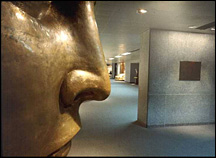The Concept of Universal Design
"Universal Design is the design of products and environments to be usable by all people, to the greatest extent possible, without the need for adaptation or specialized design" (U NC. 2020).
There are examples of universal design in your everyday life. For example, curb cutouts at street intersections allow people who walk and roll to cross independently if they have the capacity. Other examples include:
Automated doors:
- allow parents to manage children and groceries at the same time
- can accommodate a teenager with a broken leg
- assist older adults with impaired arm strength
Automated sinks:
- save water resources
- are more hygienic
- allow for use by most regardless of age or disability
Most people may not be aware of how Universal Design can positively affect a diverse group of individuals.
 For example:
For example:
Oh, what a nose!
One of the most memorable experiences of a visit to the Statue of Liberty is touching a scale model of the face of Lady Liberty. Imagine touching a nose that is 4'6" long!
The opportunity to touch the model allows for a universally designed experience because nearly all people experience the grand scale of the Statue, not just those who can see it.
Reading can be hearing for some people.
In a busy, loud airport, an open-captioned television monitor allows travelers to access the latest news, weather, and other topical information. Reading the words in addition to hearing them makes access possible for those individuals who do not hear well in a loud place or have no hearing at all.
